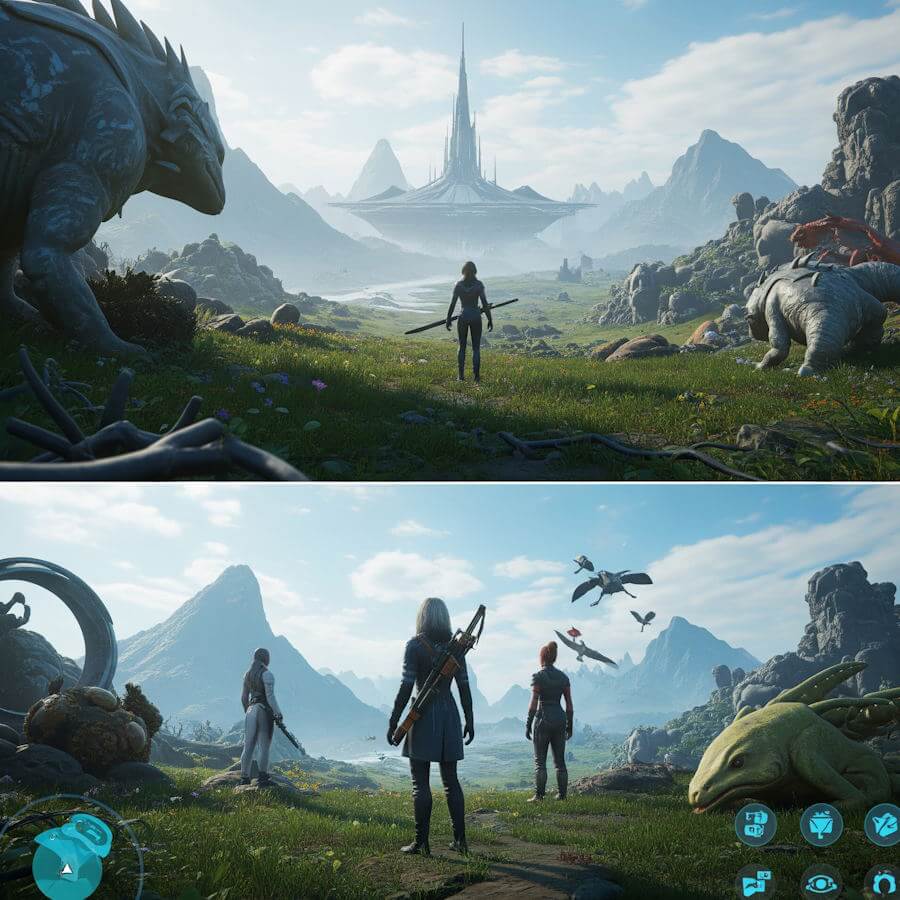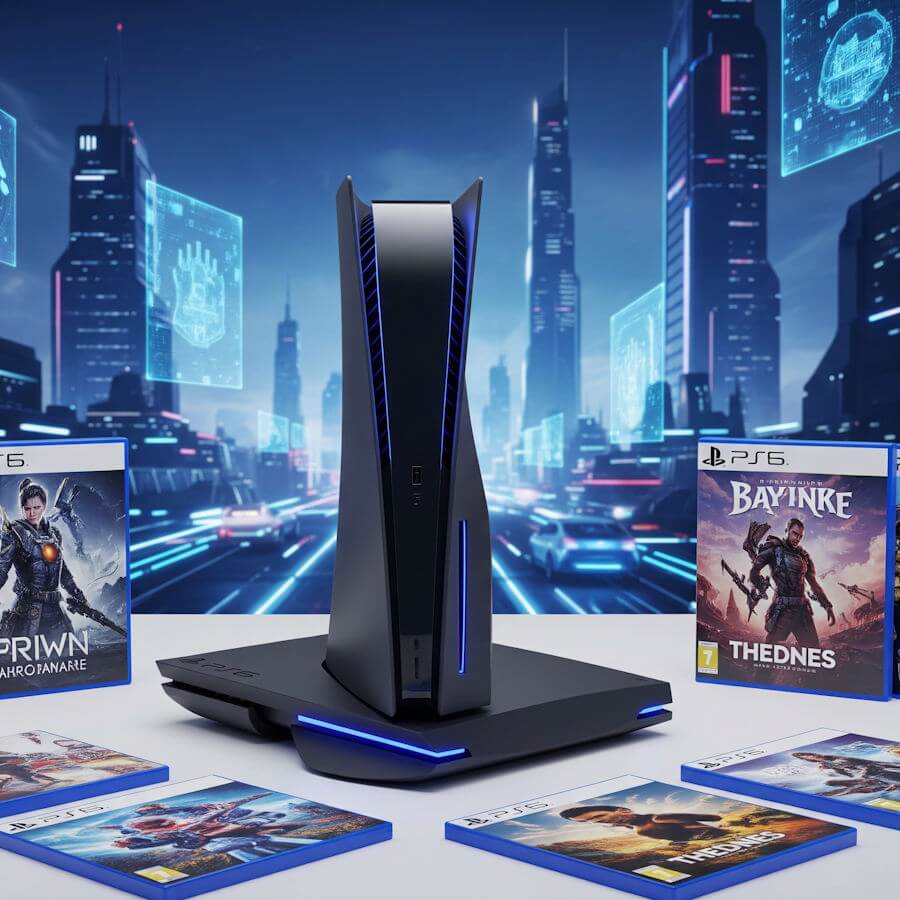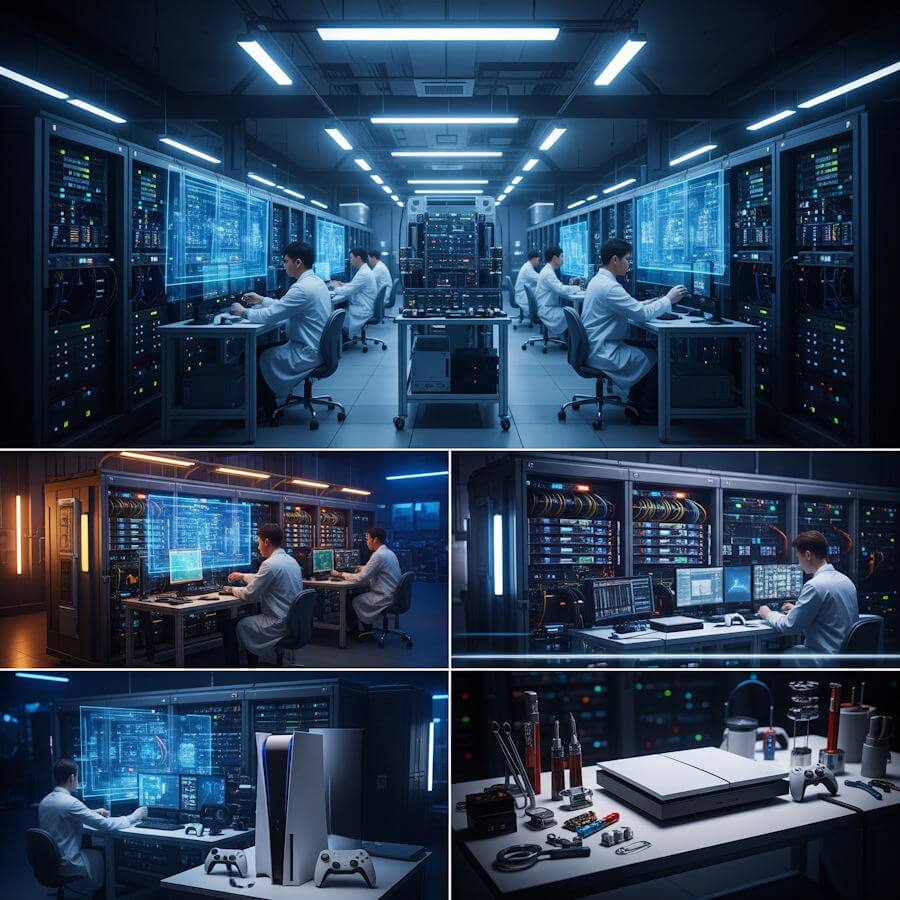Introduction to PS6 and its Game Library
The PlayStation 6 (PS6) represents the next significant milestone in the evolution of gaming consoles, building upon the legacy of its predecessors by incorporating cutting-edge technology and innovative design. With its anticipated release, the PS6 is set to revolutionize both hardware capabilities and gaming experiences. This console is engineered to support higher graphical fidelity, improved processing power, and advanced artificial intelligence, which collectively enhance gameplay realism and immersion. Furthermore, the PS6 aims to cater to a broad spectrum of gamers, from casual players to competitive enthusiasts, demonstrating the industry’s commitment to inclusivity and diversity in gaming.
The PS6’s game library is as significant as the console itself, featuring a range of genres that appeal to various audiences. This library not only includes sequels to beloved franchises but also introduces fresh IPs that push the boundaries of storytelling and gameplay mechanics. By examining the games available on the PS6, we gain insights into contemporary trends in game design, such as the increasing importance of narrative depth, environmental interaction, and player agency. Notably, the integration of virtual reality (VR) and augmented reality (AR) experiences within some titles demonstrates an evolution in how players engage with the game world, offering new dimensions to gameplay.
Exploring PS6 games provides valuable perspectives on how developers are addressing current gaming demands and laying the groundwork for future innovations in game design. As we anticipate the full unveiling of the PS6 and its titles, it becomes increasingly clear that this console will not only set new benchmarks for performance but will also reflect the changing landscape of user preferences and technological advancements in the gaming industry.
Technological Advancements in Game Design
The PlayStation 6 (PS6) represents a significant leap forward in the realm of game design, primarily due to its integration of cutting-edge technologies that enhance both graphics and gameplay mechanics. One of the most notable advancements is the enhancement of graphics capabilities through more powerful GPUs, enabling developers to create hyper-realistic environments and characters. This improved graphical fidelity not only immerses players deeper into the gaming world but also allows for a broader range of storytelling possibilities, where visuals play a pivotal role in the narrative experience.
Another important facet of the PS6 is the application of artificial intelligence (AI) in game design. The PS6’s advanced AI systems can create dynamic and responsive non-player characters (NPCs) that behave more realistically within the game environment. These improvements facilitate more engaging interactions and lead to more unpredictable yet rewarding gameplay experiences. For instance, titles like “Beyond Reality,” which harnesses these AI advancements, offer players a personalized narrative journey where NPCs react to choices in a more human-like manner, significantly enriching the player’s immersion.
Additionally, the rise of virtual reality (VR) on the PS6 platform further transforms the gaming landscape. With the incorporation of sophisticated VR technology, developers are empowered to craft experiences that fully envelop players, allowing them to explore virtual worlds with their own movements. Games such as “VR Adventure: Quest for Tomorrow” illustrate how such immersive technology can elevate traditional gameplay mechanics, creating an interactive experience that challenges the boundaries of conventional gaming.
In summary, the PS6 is at the forefront of technological advancements in game design, effectively enhancing storytelling and gameplay through improved graphics, sophisticated AI, and immersive VR. These innovations not only enrich current titles but set the stage for the future of gaming, redefining how stories are told and experienced in virtual environments.
Narrative Evolution in PS6 Games
The evolution of narratives within PS6 games marks a significant shift in how stories are crafted and delivered in the gaming industry. As technology advances, developers are increasingly exploring innovative storytelling techniques that not only enhance the plot but also immerse players in a more dynamic experience. Unlike previous generations, PS6 games are designed with a strong emphasis on character development, allowing players to form deeper connections with protagonists. This evolution is largely driven by the rise of complex characters that possess rich backstories and relatable motivations, leading to a more engaging gameplay experience.
One of the prominent trends observed in PS6 games is the integration of interactive storytelling, where player choices significantly impact the narrative’s progression. This approach provides players with a sense of agency, allowing them to influence the direction of the story in meaningful ways. As a result, games have become less linear, embracing branching narratives that cater to diverse player preferences and playing styles. Such interactivity is a response to evolving audience expectations, which increasingly favor more personalized gameplay experiences.
The narrative trends seen in PS6 games also reflect a broader cultural shift towards inclusivity and representation. Developers are actively incorporating diverse characters and stories that resonate with a wider audience. This change not only enriches the gaming landscape but also fosters a sense of belonging among players, who can see themselves represented in the virtual worlds they explore. Furthermore, the shift towards more engaging narratives is complemented by advancements in technology, such as enhanced graphics and AI-driven storytelling, which help to create immersive worlds that captivate players.
As we analyze these trends, it becomes evident that the future of game design is leaning toward more intricate and engaging narratives, reshaping how stories are told and experienced in gaming. This evolution will continue to influence new titles, ensuring that players remain at the forefront of narrative development in the gaming realm.
User Experience and Interface Design Trends
The user experience (UX) and interface design are critical components of modern game development, significantly influencing player engagement and satisfaction. As the gaming landscape evolves with the upcoming PS6, emerging trends in UX and interface design will become increasingly apparent. Developers are prioritizing intuitive controls that facilitate seamless interaction, allowing players to immerse themselves in the gaming experience without unnecessary distractions.
One of the pivotal trends is the emphasis on accessibility. Games designed for the PS6 are likely to incorporate features that cater to a diverse audience, ensuring that players of varying abilities can enjoy the gameplay. Accessibility options could include customizable control schemes, subtitles, and visual aids; these elements are essential for fostering inclusivity and expanding the player base. For instance, recent PS5 titles have already begun to implement such features, enhancing the overall user experience and setting a precedent for future PS6 games.
Moreover, immersive interfaces—those that blend smoothly with gameplay—are becoming a standard expectation among gamers. Design choices that reflect a game’s theme and narrative contribute to deeper player engagement. An example can be seen in the use of HUD elements that adapt contextually to the gameplay, providing essential information without overwhelming the player. In many current PS5 games, developers are experimenting with holographic displays and dynamic menus that respond to player input, creating a fluid interaction that feels natural and engaging.
In conclusion, the user experience and interface design trends observed in PS6 games will greatly impact how players interact with digital environments. The focus on intuitive controls, accessibility features, and immersive interfaces will not only improve engagement but also enrich the overall enjoyment of gaming on the next generation of consoles.
The Rise of Multiplayer and Community Integration
The landscape of video gaming has undergone significant transformations over the years, with multiplayer experiences and community integration emerging as central elements in modern game design. As gaming technology evolves and players seek more immersive interactions, these aspects are set to redefine how games are developed for upcoming consoles like the PS6.
Firstly, the rise of online cooperative gameplay is becoming increasingly prominent in the PS6 gaming ecosystem. Developers are recognizing that players enjoy not just competing against one another, but also teaming up to tackle challenges collaboratively. This trend has led to the creation of games that focus on teamwork and shared objectives, encouraging players to forge connections while engaging in communal gameplay. Resultantly, embracing cooperative mechanics can enhance social dynamics, making the gaming experience more engaging and multifaceted.
Furthermore, the integration of player-driven content has reshaped the way games are consumed. Players are no longer passive participants; they are active contributors to the gaming world. With the advent of user-generated content, developers are empowering players to create their own experiences, which can significantly alter the game landscape. This not only increases player investment but also allows for diverse and evolving gameplay that can keep the community engaged over time.
Lastly, social interactions within games are becoming essential for fostering community. Features such as in-game messaging, social hubs, and collaborative events encourage players to connect beyond just gameplay. These elements facilitate discussions and friendships among gamers, solidifying communities around particular titles. As game designers look to the future, they must consider how to further integrate these social experiences to enhance player satisfaction and loyalty.
In conclusion, the emphasis on multiplayer experiences and community integration in PS6 games signifies a major shift in game design priorities, impacting how developers will approach creating immersive and interactive environments that appeal to a diverse audience.
Diversity and Representation in Game Design
The trend of integrating diversity and representation in game design has become increasingly prominent with the advent of gaming consoles like the PS6. Game designers are recognizing the importance of diverse narratives and character backgrounds, which not only reflect the multifaceted society we live in but also cater to a broader audience. By presenting characters from various ethnicities, genders, and cultures, developers are illustrating stories that resonate with a wider range of players, enriching the gaming experience.
Focusing on diversity enables game creators to explore stories that may have been overlooked in previous generations of gaming. This offers players the opportunity to engage with unique perspectives, fostering empathy and understanding among diverse groups. In PS6 games, we are witnessing a shift from traditional character archetypes towards more nuanced representations, including characters who embody complex personal struggles, cultural heritage, and varied worldviews. This evolution in character design not only diversifies gameplay but also enhances narrative depth, enriching the players’ emotional engagement.
The implications of these design choices extend beyond individual games; they signal a substantial shift within the gaming industry towards inclusivity. As game developers prioritize representation, they set a new standard that emphasizes the importance of diverse storytelling. This movement is likely to encourage greater creativity among storytellers, who will feel empowered to devise original plots that incorporate varied cultural influences. Consequently, as the gaming ecosystem evolves, there is a potential for greater acceptance and appreciation of differences, making the industry more welcoming for players from all walks of life.
In conclusion, the increasing emphasis on diversity and representation in PS6 games marks a pivotal shift in game design that aims to cultivate a more inclusive and engaging world for players. This trend is expected to shape the future of gaming, forcing industry stakeholders to reconsider traditional norms and embrace a broader spectrum of stories that reflect the realities of a global society.
Monetization Models Shaping Game Development
As the gaming industry evolves, monetization models have become a significant factor influencing the design and development of PS6 games. The shift from traditional pay-to-play models to free-to-play titles is a notable trend that marks this transformation. These free-to-play games often generate revenue through in-game purchases, battle passes, and cosmetic upgrades. Such strategies not only affect the financial health of gaming companies but also shape the player’s overall experience and engagement with the titles.
Incorporating in-game purchases into game design necessitates a careful balance to avoid alienating players. Developers aim to create an environment where gamers feel that they can engage meaningfully without mandatory spending. The excitement surrounding PS6 game releases highlights the growing emphasis on ensuring that in-game purchases enhance rather than detract from gameplay. Players should feel that their achievements and progress stem from their skills, not merely from their financial investment.
Furthermore, these monetization models are redefining long-term sustainability within franchises. By prioritizing consistent updates and expansions, developers can keep their player base engaged while generating ongoing revenue. This approach allows for the creation of immersive worlds that evolve over time, enticing players to return frequently. However, this dynamic can also pressure developers to create a continuous stream of content, influencing design choices significantly.
As PS6 games continue to integrate various monetization strategies, it will be essential to monitor how these models impact player retention and satisfaction. Developers must be attentive to player feedback regarding in-game purchases as they navigate the complex landscape of monetization while striving to deliver enjoyable and innovative experiences. Ultimately, finding equilibrium in monetization practices will be critical for the future of game design.
Player Feedback and Community Impact on Game Design
In recent years, the incorporation of player feedback has become an integral part of game design, particularly in the development of PS6 games. Developers increasingly recognize that engaging with their gaming communities can result in a more enriched gaming experience. Through various platforms such as forums, social media, and dedicated feedback channels, players are provided with the opportunity to express their thoughts and suggestions, which in turn influences the direction of development. This collaborative approach not only enhances the end product but also fosters a sense of ownership among players.
One of the critical methods for integrating player feedback is through beta testing and early access programs. By allowing a select group of players to experience a game prior to its official launch, developers can gather invaluable insights into gameplay mechanics, performance issues, and overall player satisfaction. These test sessions serve as a testing ground for innovative ideas and concepts, giving developers a chance to make necessary adjustments based on real-time player experiences. Consequently, this leads to a more polished final product that resonates well with the public.
Moreover, developers are becoming adept at utilizing player suggestions to adapt content dynamically. Whether it involves tweaking game balance, altering difficulty levels, or introducing new features, the ability to respond to community input is a hallmark of contemporary game design. This responsiveness not only translates into a more engaging gameplay experience but also builds trust between developers and players. In the realm of PS6 games, nurturing a symbiotic relationship with the community is essential, as it reflects an ongoing commitment to defining the ever-evolving landscape of gaming.
Future Trends: What Lies Ahead for Game Design
The landscape of game design is continually evolving as new technologies and player preferences shape the gaming experience. With the anticipated launch of the PlayStation 6 (PS6), the gaming industry is positioned on the brink of several transformative trends. One of the most prominent directions involves the integration of advanced artificial intelligence. Game designs are likely to increasingly incorporate AI to create more dynamic and responsive gaming environments, which adapt in real time to the player’s choices and actions. This evolution promises to enhance narrative depth and player engagement, ultimately resulting in immersive experiences that were previously unattainable.
In parallel, the advent of cloud gaming technologies is expected to reshape how gamers access and interact with their favorite titles. Enhanced bandwidth and improved streaming services will facilitate gameplay without the necessity of high-end hardware. This shift could democratize gaming, making high-quality games accessible to a wider audience and influencing design philosophies that prioritize inclusivity and cross-platform compatibility.
Moreover, the increasing trend of player-generated content cannot be overlooked. Games that provide tools for players to create their own levels, characters, and narratives allow for deeper engagement and personal investment. As this trend continues, we may see a shift in design structures, focusing on frameworks that encourage user contribution and collaboration. The implications for community-building and longevity of titles are profound, as developers will need to balance guided experiences with user-generated creativity.
Lastly, sustainability in game design is emerging as a crucial consideration. As environmental awareness grows, developers will likely prioritize eco-friendly practices in the production of games, leading to a new genre of sustainable gaming that reflects players’ values. Looking ahead, these trends—AI integration, cloud gaming, user-generated content, and sustainability—are poised to redefine the gaming landscape as we anticipate the arrival of the PS6 and beyond.





